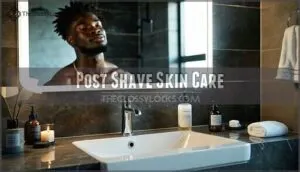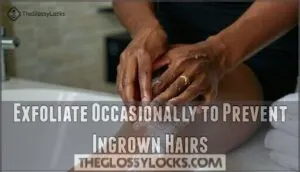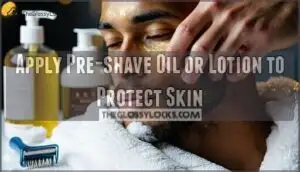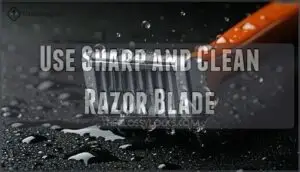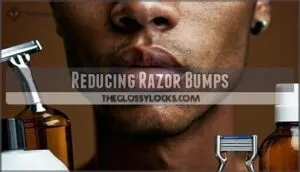This site is supported by our readers. We may earn a commission, at no cost to you, if you purchase through links.
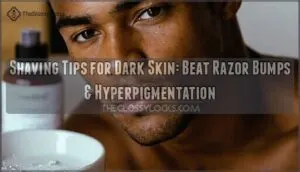
You’ll want to cleanse gently, exfoliate regularly with salicylic acid, and apply pre-shave oil before picking up that razor.
Always shave with the grain using a sharp, single-blade razor, and don’t press too hard.
After shaving, rinse with cold water, skip alcohol-based aftershaves, and moisturize thoroughly. The key is treating your skin like the delicate canvas it is, not attacking it like you’re clearing brush.
Master these fundamentals, and you’ll discover why timing, technique, and the right products make all the difference.
Table Of Contents
- Key Takeaways
- Shaving Prep Tips
- Shaving Techniques Matter
- Post Shave Skin Care
- Hyperpigmentation Prevention
- Reducing Razor Bumps
- Frequently Asked Questions (FAQs)
- How to cure dark skin due to shaving?
- How to get rid of razor bumps on black skin?
- Does shaving darken the pubic area?
- How to get rid of dark stubble after shaving?
- How often should I replace my razor blade?
- Can I shave daily without causing irritation?
- What ingredients should I avoid in shaving products?
- How long does hyperpigmentation take to fade?
- Conclusion
Key Takeaways
- Prep your skin properly – You’ll need to cleanse gently, exfoliate 2-3 times weekly with salicylic acid, and apply pre-shave oil to create a protective barrier that prevents razor bumps and hyperpigmentation.
- Master your shaving technique – You should always shave with the grain using a sharp, single-blade razor with light pressure, and rinse your blade after every few strokes to prevent irritation.
- Follow proper post-shave care – You’ll want to rinse with cold water, skip alcohol-based aftershaves, moisturize thoroughly, and apply SPF 30+ sunscreen to prevent dark spots from forming.
- Stay consistent with prevention – You cannot skip regular exfoliation, proper hydration, and gentle techniques if you want to avoid the cycle of razor bumps and hyperpigmentation that affects dark skin.
Shaving Prep Tips
Proper prep work makes all the difference when you’re dealing with sensitive skin that’s prone to razor bumps and dark spots.
You’ll want to start with a gentle cleanse, followed by regular exfoliation and a good pre-shave oil to create that protective barrier your skin needs.
Cleanse Face With Gentle Cleanser
Your skin deserves respect before you even pick up that razor. Start with a gentle cleanser that removes dirt and oil without stripping your skin’s natural barrier, setting the stage for a smooth shave.
Here’s your cleansing game plan:
- Choose hydrating cleanser types with ingredients like ceramides or hyaluronic acid
- Focus on cleansing frequency matters – cleanse twice daily, morning and evening
- Master cleansing technique importance by using lukewarm water and gentle circular motions
- Prioritize cleanser ingredient focus – avoid harsh sulfates that can irritate dark skin
This gentle cleanser benefits approach protects your skin from the irritation that leads to razor bumps and dark spots during sensitive skin shaving.
A key step involves cleansing with warm water to open pores.
Exfoliate Regularly to Prevent Ingrown Hairs
After cleansing, regular exfoliation becomes your secret weapon against ingrown hairs.
Dead skin cells pile up like autumn leaves, blocking hair follicles and creating the perfect storm for razor bumps. Gentle exfoliation two to three times weekly clears this debris, letting hairs grow freely without getting trapped beneath the surface.
Clear skin starts with clearing out the clutter that blocks healthy hair growth.
Many people find success with gentle exfoliating products for this purpose.
| Exfoliation Type | Best For | Frequency |
|---|---|---|
| Chemical Exfoliants | Sensitive skin, deep cleaning | 2-3 times weekly |
| Physical Exfoliation | Normal skin, manual scrubbing | 1-2 times weekly |
| Enzyme Exfoliants | Very sensitive skin | 1-2 times weekly |
| Combination Method | All skin types | Alternate weekly |
Use Salicylic Acid-based Exfoliants for Ingrown Hairs
Salicylic acid works like a gentle bulldozer, clearing dead skin cells that trap hairs beneath the surface.
You’ll want 1-2% concentration for daily use – strong enough for ingrown hair prevention without irritating dark skin.
This beta hydroxy acid penetrates pores, dissolves buildup, and reduces inflammation that causes razor bumps.
Start with every other day if you have sensitive skin, then increase frequency as tolerated.
It also prevents bacterial growth, and using salicylic acid benefits ingrown hairs.
Apply Pre-shave Oil for Lubrication
Think of pre-shave oil as your skin’s best friend before the razor touches down.
This protective barrier reduces friction, making each stroke smoother and gentler on dark skin.
Oil benefits include preventing razor burn and hyperpigmentation that commonly affects darker complexions.
Application techniques matter: massage a few drops into damp skin, focusing on areas prone to irritation.
You can find pre shave products online.
Quality oil ingredients like jojoba or argan work best for skin hydration and sensitivity concerns.
Alternative lubricants include hair conditioner or body oil when preshave oil isn’t available.
Shaving Techniques Matter
How you shave matters just as much as what you use, especially when you’re dealing with sensitive dark skin that’s prone to razor bumps and discoloration.
The right technique can mean the difference between smooth, clear skin and weeks of dealing with irritation and dark spots, which is why technique is crucial.
Shave in Direction of Hair Growth
Going with the grain isn’t just old-school wisdom—it’s your ticket to smooth, bump-free shaving on dark skin.
Follow the grain, skip the pain—your skin knows the way to a smooth shave.
Hair mapping helps you identify growth patterns before you start. Shaving direction matters because following natural hair growth minimizes irritation and prevents those stubborn ingrown hairs that love to show up uninvited.
This technique refinement keeps your skin happy, and by doing so, it ensures smooth and bump-free results, making the overall experience more pleasant.
Use Sharp Razor Blades for Smooth Shave
Your razor blade sharpness directly impacts your shaving experience. Sharp blades cut hair cleanly without tugging, reducing skin irritation and preventing razor bumps that plague dark skin shaving.
Dull blades create micro-tears, triggering hyperpigmentation. Change blades after 5-10 shaves for ideal razor hygiene.
Single-blade razors work best for dark skin, providing smooth shaves while minimizing trauma. Shaving can indeed lead to post-inflammatory hyperpigmentation.
Avoid Pressing Too Hard on Skin
Now that your blade’s sharp, let’s talk pressure. Many people press down hard, thinking it’ll give a closer shave, but that’s when razor burn strikes hardest on dark skin.
Light strokes work better than heavy-handed scraping. Here’s how to master gentle pressure:
- Hold your razor like a feather, not a chisel
- Let the blade’s weight do the work naturally
- Keep blade angle at 30-45 degrees for ideal cutting
- Adjust shaving frequency if irritation persists
Remember, dark skin sensitivity means less is more in terms of pressure.
Rinse Razor After Every Few Strokes
Clean water runs through your razor, washing away hair and cream buildup that blocks the blades.
This simple step keeps each stroke smooth and prevents tugging on dark skin, reducing irritation that leads to razor bumps and hyperpigmentation.
To maintain hygiene, it’s also vital to dry the razor after each use.
| Rinse Frequency | Benefits for Dark Skin |
|---|---|
| Every 2-3 strokes | Prevents clogging, maintains blade sharpness |
| After thick hair sections | Removes debris, guarantees clean cutting |
| When cream accumulates | Maintains shaving efficiency, reduces drag |
| Before final passes | Optimizes razor lifespan, prevents irritation |
| End of shaving session | Promotes blade hygiene, prevents bacteria |
Post Shave Skin Care
After you’ve finished shaving, your skin needs immediate care to prevent irritation and dark spots. Cold water, gentle aftershave, moisturizer, and sunscreen form your defense against razor bumps and hyperpigmentation.
Rinse With Cold Water to Close Pores
After shaving, splash cold water on your face to snap those pores shut.
This cold water rinse reduces inflammation and minimizes pore size, preventing dirt and bacteria from settling in.
The cold water benefits include soothing skin irritation and calming any redness from your shaving session.
This simple post-shave routine step helps maintain smooth skin and prevents breakouts common in shaving dark skin.
Apply Alcohol-free Aftershave With Soothing Ingredients
After closing pores with cold water, you’ll want to soothe freshly shaved skin with alcoholfree aftershave containing gentle ingredients.
This postshave care step helps prevent shaving irritation and razor bumps treatment while promoting skin hydration.
Choose products with these aftershave ingredients for maximum soothing benefits:
- Aloe vera – reduces inflammation and moisturizes sensitive skin
- Witch hazel – acts as natural astringent without alcohol’s harsh sting
- Vitamin E oil – promotes healing and prevents irritation reduction
- Tea tree oil – provides antiseptic properties for aftershave dark skin needs.
These alcohol alternatives won’t strip your skin’s natural moisture barrier like traditional aftershaves can.
Moisturize to Hydrate and Protect Skin
After shaving, your skin craves hydration to bounce back from the razor’s work.
Choose moisturizers with hyaluronic acid and natural ingredients like shea butter for sensitive skin.
Daily moisturizing prevents dark spots, maintains your skin barrier, and keeps dark skin smooth.
Quality product selection makes all the difference in your shaving routine.
Use Sunscreen With SPF 30 or Higher
After your post-shave routine, don’t skip the sunscreen – your freshly shaved dark skin needs SPF 30 or higher for UV protection.
Daily sunscreen prevents pigmentation issues that can worsen razor bumps and dark spots.
Reapply every two hours, especially after sweating, since skin sensitivity peaks after shaving and UV rays can trigger hyperpigmentation.
Hyperpigmentation Prevention
Hyperpigmentation from shaving happens when razor bumps and irritation create dark spots on your skin.
You can prevent this frustrating cycle by taking simple steps before you pick up that razor.
Use Gentle Face Wash to Remove Dead Skin Cells
Dead skin cells clog pores and trap bacteria, creating the perfect storm for razor bumps on dark skin.
Regular skin cleansing with hydrating cleansers removes this buildup, preparing your skin for a smoother shave. Choose gentle, fragrance-free products designed for sensitive skin.
Soothing ingredients like feverfew can further reduce irritation.
- Freedom: Break free from painful razor bumps that steal your confidence
- Control: Take charge of your grooming routine with proper cleansing frequency
- Victory: Win the battle against hyperpigmentation through smart ingredient analysis
Exfoliate Occasionally to Prevent Ingrown Hairs
Regular exfoliation breaks down the buildup that traps hairs beneath your skin’s surface, creating those frustrating bumps.
Choose chemical exfoliants like salicylic acid over physical scrubs, as they’re gentler on dark skin and reduce irritation.
Limit exfoliating dark skin to 2-3 times weekly to prevent sensitivity while maintaining effective ingrown prevention through consistent dark skin grooming techniques.
Apply Pre-shave Oil or Lotion to Protect Skin
Pre-shave oil creates a protective barrier between your skin and razor, reducing friction that triggers hyperpigmentation.
Choose oils with natural ingredients like jojoba or argan for ideal skin preparation.
Apply a thin layer before shaving cream, massaging gently into dark skin.
This preshave routine enhances shaving lubrication, preventing razor drag that causes inflammation and discoloration in darker complexions, which is crucial for reducing hyperpigmentation.
Use Sharp and Clean Razor Blade
A dull blade is your skin’s worst enemy, dragging and tugging instead of cutting cleanly.
You need sharp razor maintenance and proper razor hygiene to prevent irritation that leads to dark spots.
Replace blades regularly, store your razor in a dry place, and rinse thoroughly after each use.
The best razors for dark skin require consistent blade material quality and correct blade angle for ideal shaving frequency results, ensuring a smooth shave every time with proper razor hygiene.
Reducing Razor Bumps
Razor bumps plague many people with dark skin, but you can fight back with the right approach.
Smart exfoliation, proper heat application, and targeted treatments will help you achieve smoother skin without the irritation.
Exfoliate With Products Containing Salicylic Acid
When you’re dealing with persistent razor bumps, salicylic acid becomes your secret weapon for smoother dark skin shaving solutions. This powerhouse ingredient gently dissolves dead skin cells while preventing ingrown hairs that lead to hyperpigmentation.
- Salicylic Benefits: Penetrates pores to unclog follicles and reduce inflammation
- Product Strengths: Choose 0.5-2% concentrations for effective yet gentle exfoliation
- Exfoliation Frequency: Start 2-3 times weekly to gauge skin sensitivity
- Skin Sensitivity: Monitor for irritation and adjust usage accordingly
- Long-Term Effects: Consistent use prevents dark spots and smooths texture
Use Hot Towel to Soften Hair Follicles
Hot towel therapy transforms your shaving routine by softening stubborn hair follicles before the razor touches your skin.
This simple skin preparation technique reduces tugging, minimizes razor burn relief, and creates ideal shave readiness for dark skin.
| Step | Action |
|---|---|
| Heat | Soak towel in hot water for 2-3 minutes |
| Apply | Press gently against face for 3-5 minutes |
| Remove | Pat skin dry, leaving slight moisture |
| Shave | Begin your shaving technique immediately |
Apply Aloe Vera or Vitamin E Oil to Reduce Inflammation
Natural anti-inflammatory compounds work wonders for post-shave skin care.
Aloe vera benefits include cooling irritated skin, while vitamin E oil uses extend to repairing damaged cells.
These soothing skin remedies promote inflammation reduction through:
- Aloe vera’s gel – Apply directly for instant razor burn relief
- Vitamin E oil massage – Prevents hyperpigmentation shaving complications
- Combined treatment – Addresses ingrown hairs naturally
Using natural remedies like razor burn prevention can help alleviate post-shave skin issues.
Consider IPL Therapy for Hyperpigmentation Treatment
While IPL therapy can target melanin and break up pigment clusters for skin tone correction.
It carries significant risks for darker skin tones. The excess melanin in dark skin can absorb more energy, potentially causing burns, scarring, or worsening hyperpigmentation.
Consult a dermatologist experienced with dark skin before considering laser skin resurfacing treatments.
Frequently Asked Questions (FAQs)
How to cure dark skin due to shaving?
Clever cleansing combats complexion concerns! You’ll need consistent exfoliation with salicylic acid, gentle moisturizing, and sunscreen protection. Try natural remedies like aloe vera or lemon juice for lightening existing spots.
How to get rid of razor bumps on black skin?
Exfoliate regularly with salicylic acid products to prevent ingrown hairs. Use sharp razors, shave with the grain, apply alcohol-free aftershave, and moisturize daily to reduce inflammation and dark spots.
Does shaving darken the pubic area?
Shaving doesn’t directly darken your pubic area, but it can trigger hyperpigmentation. Razor bumps, irritation, and inflammation from improper technique cause dark spots over time, especially on sensitive skin.
How to get rid of dark stubble after shaving?
That pesky shadow can feel like a stubborn guest who won’t leave!
Try exfoliating gently with salicylic acid, moisturizing daily, and using vitamin E oil to lighten dark spots over time.
How often should I replace my razor blade?
Replace your razor blade every 5-7 shaves or when you notice tugging, increased irritation, or difficulty rinsing hair and debris from between the blades during use.
Can I shave daily without causing irritation?
Daily shaving is possible without irritation if you follow proper techniques. Use sharp blades, shave with the grain, apply quality shaving cream, and moisturize afterward to prevent razor burn.
What ingredients should I avoid in shaving products?
Around 68% of razor bumps stem from harsh product ingredients, making your choice essential for healthy skin.
Avoid alcohol, sulfates, and synthetic fragrances in shaving products—they’ll strip your skin’s natural oils and trigger irritation, especially on sensitive areas.
How long does hyperpigmentation take to fade?
Hyperpigmentation typically fades within 6-12 weeks with proper care, but deeper dark spots can take several months to fully lighten, depending on your skin’s healing response.
Conclusion
Studies show that men of color experience razor bumps at rates up to 80% higher than other demographics, making proper technique essential for healthy skin.
These thorough shaving tips for dark skin aren’t just suggestions—they’re your roadmap to smoother, bump-free results.
Remember, consistency beats perfection, so stick with gentle cleansing, regular exfoliation, and quality products.
Your skin will thank you for treating it with the respect it deserves.
- https://www.aocd.org/page/pseudofolliculitisb
- https://getbevel.com/blogs/articles/why-do-black-men-get-razor-bumps
- https://arvivaesthetics.com/blog/can-shaving-cause-hyperpigmentation/
- https://byaaronwallace.com/en-us/blogs/grooming-guide/5-common-skin-care-issues-for-black-men-and-how-to-treat-them
- https://shop.frederickbenjamin.com/blogs/the-journal-mens-grooming-and-lifestyle-content/shaving-for-black-men-best-practices-product-recommendations





